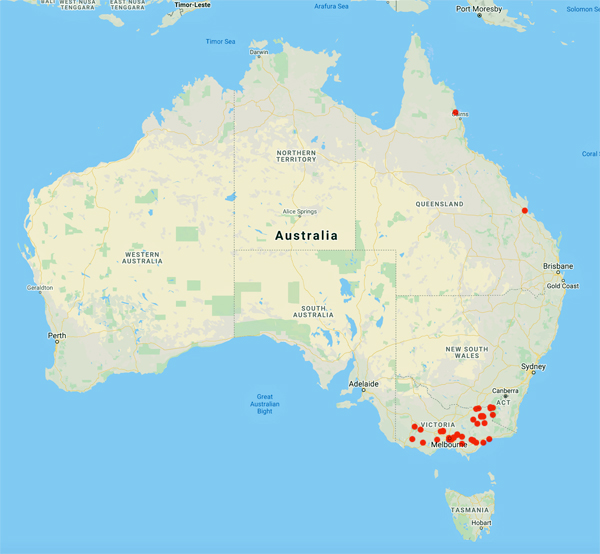

 |
 |
|
Born in Tasmania 22 February 1845, she died at Drouin, Vic, aged 78 of breast cancer on 13 March 1923
Born in Tas., one of four children, to pioneer Victorian colonist, whaler and trader, Captain Alexander Campbell (1805-1891), and Ann née Coulson.
The Campbells established themselves in Port Fairy, where Flora's father had built a house for his sisters. In 1851, Flora's father was appointed the first harbourmaster of the Port of Melbourne and held this position until his retirement in 1869. In c.1872, the family established a grazing property at Fulham, Gippsland, which was successful.
Flora, her sister, Ann, and her parents visited Scotland, 1877-1879. The family spent a few more years in Fulham before moving to South Yarra. Flora was an early member of the FNCV with a special interest in cryptogams. Flora collected MEL specimens (as 'Miss Flora Campbell') in Vic. at Fulham, 1880; Hume River, 1881, 1887; Brighton, 1883; Grampians 1883-1884; Buffalo Range, 1884; Lake Deepwater, 1884; Lakes Entrance, 1884; Mount Hotham, 1884-1886; Upper Yarra, 1884; Domain (South Yarra), 1885; Dandenong Ranges, 1885; Heyfield, 1885; Oakleigh, 1885, 1887; Seaton, 1885; Penshurst, 1886; Port Phillip, 1886; Lilydale, 1887, 1889-1890; Mordialloc, 1887; Macedon, 1889; and Ararat, north Bogong area, Fernshaw, Mitta Mitta, Mounta Macedon, Ovens River, Sandringham, and Snowy River, n.d.; in NSW, at Mount Kosciuszko, 1881; Tooma Rapids and Uralla, 1882; Bourke, 1884; and, in Tas., at the Tamar River and Thorpe, 1885.
Many of Flora's specimens bear the labels of F.M. Reader, or are in his handwriting.
In 1888, Flora was employed by the Department of Agriculture to investigate the hop-spider in Gippsland.
Later in 1888 she married a widower, William Martin (c.1830-1909), a contractor from Brighton. They did not have any children. They established a grazing property at 'Weebar', near Drouin, c.1892. Flora collected MEL specimens (as 'Mrs Flora Martin') in Vic. at Beaconsfield, Kiewa, Serviceton and Trevethan Creek, 1889; and at Korumburra and Watts River, 1891; and, in Qld, Cairns, 1890.
Flora collected types of Goodenia pusilliflora F.Muell.
(1888), Dicranum senex Mull.Hal. (1897),
and types of the following
fungi:
Sphaeropsis eucalypti Berk. & Broome (1887),
Tremella microscopica Berk. & Broome (1887),
Tympanis toomansis Berk. & Broome (1887),
Agaricus prasinus Cooke & Massee (1889),
Agaricus pulchellus Cooke & Massee (1889),
Aulographum eucalypti Cooke & Massee (1889),
Bovista anomala Cooke & Massee (1889),
Cercospora daviesiae Cooke & Massee (1889),
Cercospora eucalypti Cooke& Massee (1889),
Gloeosporium hedycaryae Cooke & Massee (1889),
Leptothyrium eucalyptorum Cooke & Massee (1889),
Phoma daviesiae Cooke & Massee (1889),
Polystigmina subgen. Martinella Cooke & Massee (1889), named for her,
Polystigmina eucalypti Cooke & Massee (1889),
Stictis emarginata Cooke & Massee (1889),
Thelephora stereoides Cooke & Massee (1889),
Agaricus flavovirens Cooke& Massee (1890),
Agaricus ruber Cooke & Massee (1890),
Asteromella acaciae Cooke (1890),
Campbellia Cooke (1890), named for her,
Diploderma pachythrix Cooke& Massee (1890),
Dothidea rugulosa Cooke (1890),
Marssonia acaciae Cooke & Massee (1890),
Pestalozziella circularis Cooke & Massee (1890),
Phacidium rhytismoideum Cooke & Massee (1890),
Phyllosticta soriformis Cooke & Massee (1890),
Puccinia rumicis-scutati var. muhlenbeckiae Cooke (1890),
Septoria martiniae Cooke (1890), named for her,
Septoria phyllodiorum Cooke & Massee (1890),
Sphaeropsis phomatoidea Cooke & Massee (1890),
Zignoella australica Cooke & Massee (1890),
Agaricus disruptus Cooke& Massee (1891),
Anthostomella lepidospermae Cooke (1891),
Aposphaeria leptospermi Cooke (1891),
Boletus brunneus Cooke & Massee (1891),
Bovista hypogaea Cooke & Massee (1891),
Cercospora epicoccoides Cooke & Massee (1891),
Cercospora kennediae Cooke & Massee (1891),
Coniosporium pterospermum Cooke & Massee (1891),
Corticium penetrans Cooke & Massee (1891),
Corticium sulphurellum Cooke& Massee (1891),
Didymosphaeria banksiae Cooke (1891),
Dothidella inaequalis Cooke (1891),
Dothiorella amygdali Cooke & Massee (1891),
Gloeosporium citri Cooke& Massee (1891),
Lasiosphaeria larvispora Cooke & Massee (1891),
Leptostromella eucalypti Cooke & Massee (1891),
Leptothyrium aristatum Cooke (1891),
Marssonia deformans Cooke & Massee (1891),
Melophia phyllachoroidea Cooke (1891),
Merulius pelliculosus Cooke (1891),
Montagnella rugulosa Cooke (1891),
Phyllachora maculata Cooke (1891),
Phyllosticta platylobii Cooke & Massee (1891),
Physalospora microstricta Cooke (1891),
Piggotia substellata Cooke (1891),
Polysaccum album Cooke & Massee (1891),
Septoria lepidospermatis Cooke & Massee (1891),
Sphaerella cryptica Cooke (1891),
Sphaerella nubilosa Cooke (1891),
Stagonospora orbicularis Cooke (1891),
Stilbospora foliorum Cooke (1891),
Stillbum caninum Cooke & Massee (1891),
Stillbum corallinum Cooke & Massee (1891),
Strobilomyces fasciculatus Cooke (1891),
Strobilomyces ligulatus Cooke (1891),
Strumella patelloidea Cooke & Massee (1891),
Trabutia parvicapsa Cooke (1891),
Trabutia phyllodii Cooke & Massee (1891),
Zignoella erumpens Cooke (1891),
Agaricus cyathoideus Cooke & Massee (1892),
Agaricus discretus Cooke & Massee (1892),
Agaricus griseus Cooke & Massee (1892),
Bolbitius candidus Cooke & Massee (1892),
Daedalea illudens Cooke & Massee (1892),
Hydnum calcareum Cooke& Massee (1892),
Hymenula eucalypti Cooke & Massee (1892),
Lenzites bifasciatus Cooke & Massee (1892),
Marasmius subroseus Cooke & Massee (1892),
Monotospora fasciculata Cooke & Massee (1892),
Oospora rutilans Cooke & Massee (1892),
Stereum pannosum Cooke & Massee (1892).
There are also Flora Martin specimens at BRI, E, G, K ('Mrs F.M. Marten', 1889, 28 fungi) and NSW.
Flora was the only woman to give a paper at the Australasian Association for the Advancement of Science conference in Melbourne, 1890. She also corresponded with F.M. Bailey, Mordecai Cooke and George Massee, was a fungi artist, and wrote letters to newspapers on fungal diseases and other botanical matters.
In 1923, she died at Drouin aged 78 of breast cancer. She left her scientific books, instruments and collections to the MacFarland Library, Ormond College, but their whereabouts are no longer known.
One letter from Flora to Mueller survives.
Source: extracted from: Maroske, Sara and Vaughan, Alison (2014) 'Ferdinand Mueller's female plant
collectors: a biographical register', Muelleria Vol.32 [consult for source references]
Data from 128 specimens
